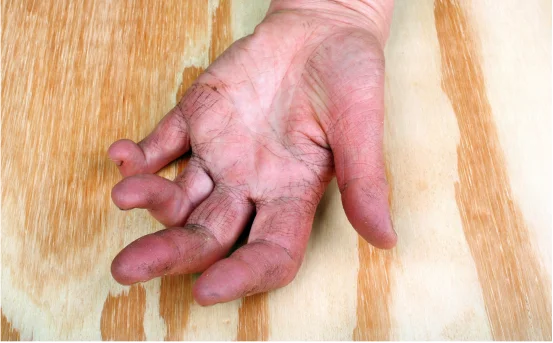Rheumatoid arthritis disease (RA) is a chronic autoimmune disorder that primarily affects the joints but can also involve other systems of the body. Unlike the wear-and-tear damage caused by osteoarthritis, RA occurs when the immune system mistakenly attacks the lining of your joints, causing inflammation, pain, and eventual joint deformity if not managed appropriately.
Understanding the symptoms of rheumatoid arthritis is crucial for early diagnosis and treatment.
RA often begins subtly, with vague symptoms such as fatigue or morning stiffness, making it difficult to recognize in its earliest stages. As the disease progresses, it can cause persistent pain, symmetrical joint inflammation, and loss of mobility. Many individuals delay seeking treatment, mistaking these early symptoms for temporary discomfort or aging-related issues yet early diagnosis is key to slowing the disease and preventing permanent joint deformity.
Awareness of the symptoms of rheumatoid arthritis can help individuals seek timely medical advice.
What Is Rheumatoid Arthritis?
Rheumatoid arthritis is an autoimmune condition where the immune system attacks the synovium—the lining of the membranes that surround the joints. This results in painful swelling, stiffness, and inflammation that can lead to joint erosion and deformities. RA typically affects the smaller joints first—like those in the hands and feet—and it tends to occur symmetrically, meaning the same joints on both sides of the body are affected.
RA can affect people of any age, but it most commonly begins between ages 30 and 60. It is more prevalent in women than in men, and symptoms often come and go in cycles called flares and remissions.
Early Symptoms of Rheumatoid Arthritis
Recognizing the symptoms of rheumatoid arthritis early can lead to better management of the condition.
Rheumatoid arthritis often begins gradually, with subtle signs that are easy to dismiss or confuse with other conditions. These early symptoms can be misleading, which is why many people delay seeking medical attention.
It’s important to note that the symptoms of rheumatoid arthritis can vary significantly from person to person.
- Fatigue
One of the earliest symptoms of RA is a persistent feeling of fatigue. This overwhelming sense of tiredness can appear weeks or even months before other symptoms manifest. It is often accompanied by a general feeling of being unwell or a lack of energy.
- Joint Stiffness
Morning stiffness is a hallmark symptom of rheumatoid arthritis. Individuals often find it difficult to move their joints after waking up, and the stiffness may last for more than 30 minutes. This contrasts with osteoarthritis, where stiffness generally resolves within a few minutes of activity.
- Mild Joint Pain and Swelling
At the onset, joint pain may be mild and affect small joints such as the fingers or toes. The joints may feel tender to the touch and slightly swollen. This discomfort often comes and goes and can switch between different joints, making it difficult to diagnose early.
Progressing Symptoms of Rheumatoid Arthritis
As the disease progresses, the symptoms of rheumatoid arthritis may include more severe joint pain and swelling.
As rheumatoid arthritis progresses, symptoms become more severe and involve more joints, sometimes spreading to larger joints such as the knees, elbows, shoulders, and hips.
Many patients report new symptoms of rheumatoid arthritis as the condition evolves over time.
- Warm, Swollen Joints
Inflammation becomes more pronounced in the affected joints, causing them to feel warm and visibly swollen. The joint may also become red and feel painful even at rest. This can severely affect mobility and day-to-day activities.
- Joint Deformity and Reduced Range of Motion
Without proper treatment, chronic inflammation in RA can damage cartilage and bone, leading to permanent joint deformities. You might notice changes in the shape of your fingers or toes, especially if RA has been present for several years. Additionally, the range of motion in the joints becomes increasingly limited.
- Symmetrical Joint Involvement
RA usually affects joints symmetrically. If one wrist is inflamed, the other wrist likely will be too. This symmetry is a distinguishing feature and helps differentiate RA from other types of arthritis.
Systemic Symptoms of Rheumatoid Arthritis
Systemic symptoms of rheumatoid arthritis can often be overlooked, but they significantly impact overall health.
Rheumatoid arthritis is a systemic condition, meaning it can affect other organs and systems beyond the joints. These symptoms may not be immediately recognized as part of RA but are important indicators of the disease’s impact.
- Low-Grade Fever
Mild fever is a common systemic symptom of RA. It often occurs during a flare-up and is usually accompanied by fatigue and general malaise. A persistent low-grade fever that is not related to any infection may indicate an autoimmune activity.
- Unintended Weight Loss
People with RA often experience unintended weight loss due to the ongoing inflammation that increases the body’s metabolic rate and can lead to muscle wasting. Loss of appetite, which sometimes accompanies chronic illness, can also contribute.
- Numbness or Tingling
RA can cause inflammation of the tissues that compress nerves, such as in carpal tunnel syndrome. This can result in numbness, tingling, or burning sensations, especially in the hands and fingers.
- Eye, Skin, and Lung Symptoms
RA may affect the eyes, causing dryness, pain, and sensitivity to light (a condition known as scleritis or dry eye syndrome). The skin can also develop rheumatoid nodules—firm lumps under the skin, usually near the elbows or fingers.
In more advanced cases, the inflammation may extend to the lungs, causing shortness of breath or chest pain due to pleuritis (inflammation of the lining around the lungs) or interstitial lung disease.
Flares and Remissions
Managing the symptoms of rheumatoid arthritis effectively requires a comprehensive treatment approach.
Rheumatoid arthritis is characterized by periods of flares, where symptoms are intense, and remissions, where symptoms may disappear or be significantly reduced. Flares can be triggered by stress, infections, overexertion, or even changes in weather. During these times, pain, swelling, and fatigue tend to worsen significantly.
Understanding personal triggers and having a treatment plan in place can help manage flares more effectively. With proper medication and lifestyle changes, many patients can experience longer periods of remission and improved daily functioning.
When to See a Doctor?
Identifying the symptoms of rheumatoid arthritis can lead to prompt intervention and better outcomes.
If you experience joint pain, swelling, or stiffness that lasts for more than a few weeks, it’s essential to consult a healthcare provider. Early diagnosis of rheumatoid arthritis is critical for slowing disease progression and minimizing long-term joint damage.
Rheumatologists doctors who specialize in arthritis and autoimmune diseases can perform blood tests (like rheumatoid factor, anti-CCP antibodies, and ESR/CRP) and imaging studies to confirm the diagnosis.
Conclusion
In conclusion, understanding the symptoms of rheumatoid arthritis is key to effective management.
Rheumatoid arthritis is a complex condition, and recognizing the symptoms of rheumatoid arthritis early can prevent serious complications.























